Gloves Lane (Blackwell) Terminal Pumping Station (2016)
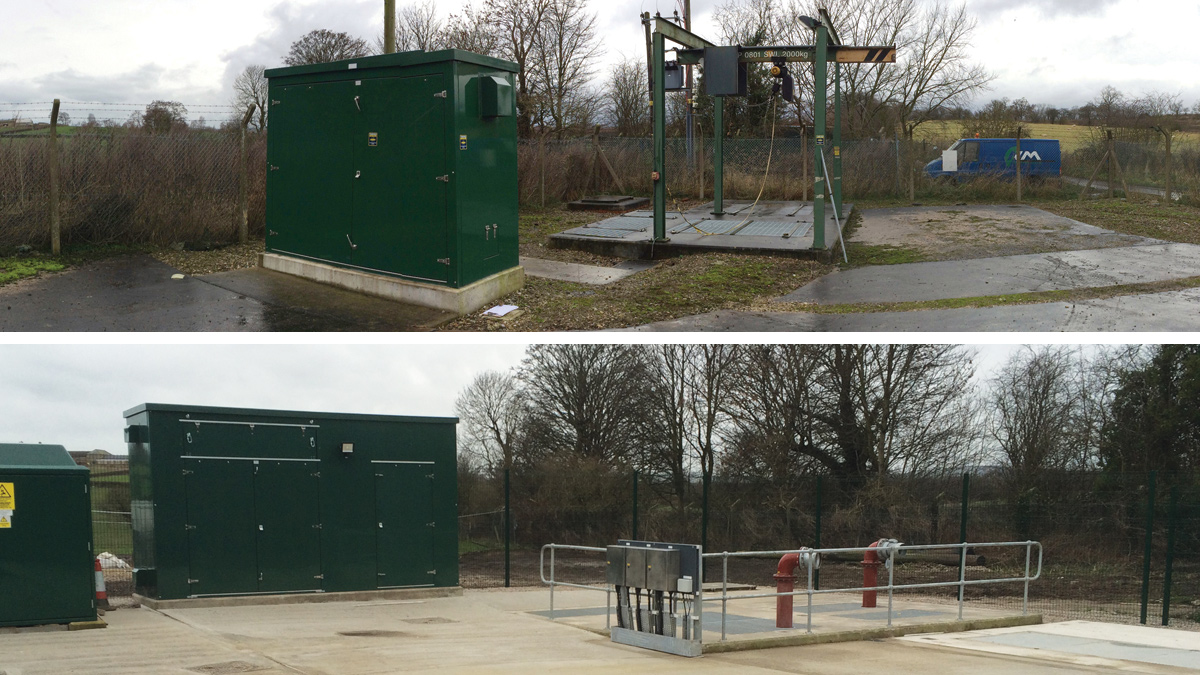
(top) Blackwell, Gloves Lane TPS before construction and (bottom) Blackwell, Gloves Lane TPS - Completed site - December 2015 - Courtesy of NMCNomenca Ltd
Blackwell is a large village in the northeast of Derbyshire, close to the town of Alfreton, with a population of approximately 3,000 people. Within the village, at the bottom of the narrow Gloves Lane, Severn Trent Water’s terminal sewage pumping station (TPS) receives significant incoming flow from not only the village itself but also the surrounding small villages – totalling approximately 7,000 people. As Blackwell and the local villages have expanded over the past decade the TPS has been placed under increasing strain and the basic lack of wet well storage had led to numerous pollution events in recent years, especially in significant rainfall events or when the mechanical equipment failed. The TPS, like the majority of UK sewage pumping stations, has a built in overflow which discharges unscreened flows into the adjacent Westwood Brook during the aforementioned events.
Project need and solution
It was clear from the outset that the TPS was in need of major overhaul to bring it up to current operational and safety standards. The lack of wet well storage and the outdated, failing mechanical equipment were the main scheme drivers. To satisfy the Severn Trent Water design criteria, 245m3 of extra storage capacity was required at the site, and the only feasible location for this extra storage volume was within the existing site compound – a constraining 273m2.
The consented pass forward flow of the site was 145 l/s and it was agreed at a very early stage that to meet this flow rate efficiently and effectively the pumping regime would be changed. The existing orientation of 2 (No.) 44kw submersible pumps on a duty/standby regime would be changed to 3 (No.) 55kw submersible pumps installed operating on a duty/assist/standby regime. This would allow the capability of having 2 (No.) pumps running in the same pump cycle, easily delivering the consented flow, whilst providing a third pump on standby to operate in the event of a pump failure during operation.
The refurbishment would also provide 3 (No.) new pump MCCs, 300mm and 350mm pipework and valves connecting onto the existing rising main, a new swing jib crane, perimeter fencing, gates and improved tanker access up to the latest Severn Trent Water standards.
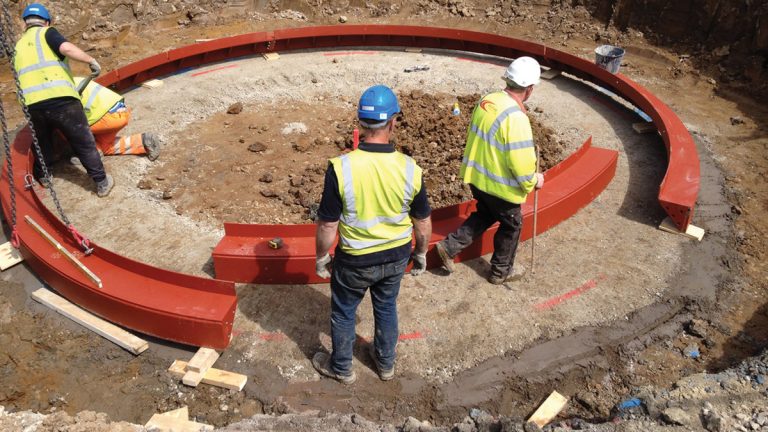
Setting of the cutting shoe – Courtesy of NMCNomenca Ltd (now Galliford Try)
Pre-construction investigation and surveys
Prior to the main construction works commencing on site a host of investigations and surveys were required due to the complexity of the refurbishment. Due to the history of coal mining in the area the initial geo-desktop study included a specific mining risk assessment that revealed a 2m thick seam of coal running through the site at a depth of approximately 8m below existing ground level. This shallow seam was identified as the ‘top hard’ seam which turned out to be one of the richest and most worked seams of coal in the entire North Derbyshire Coalfield due to its high burning quality.
As a result of the risk assessment data, the decision was immediately taken to carry out extensive borehole investigations at the site to depths well below where both new shafts would terminate.
The results confirmed the team’s initial fears, that the seam had been worked and significant underground voids were present. Before the sinking of any new shafts would commence, major underground stabilisation would be required.
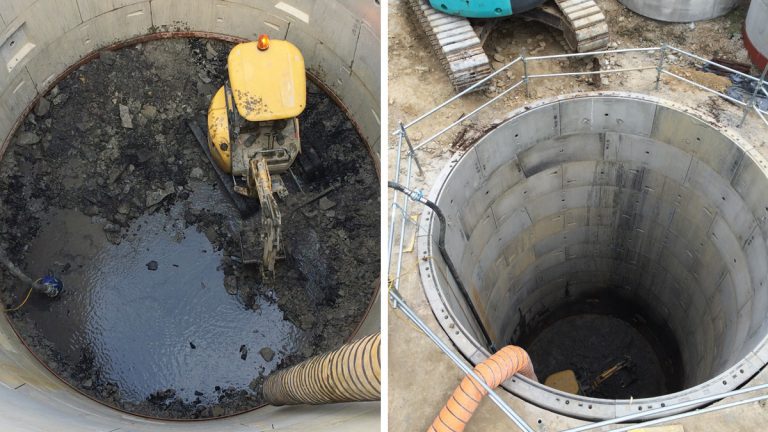
(left) Excavator sat on the ‘top hard’ seam and (right) main shaft at final depth – Courtesy of NMCNomenca Ltd
Project management & construction
The designs were finalised and approved for construction by Severn Trent Water in December 2014. Following the initial works of setting up the site welfare facilities and compound, the major construction works began in April 2015.
Phase 1 – Ground stabilisation: Prior to the main shaft sinking works commencing, the coal seam was to be drilled and filled with a high specification grout which would mitigate the risk of any ground collapse both during and post the construction stage of the project.
Over the course of eight days in April 2015, 20 (No.) separate holes were drilled at the site into the coal seam and grout was then injected into the voids and former workings to ensure the ground would be safe for the next phase of the project.
Phase 2 – Sinking of the new shafts (and connections between): The main 6m diameter shaft was to be sunk via the traditional dry caisson method (segmental sections) by Active Tunnelling Ltd, who were employed by NMCNomenca (now Galliford Try) as the principal sub-contractor for this part of the construction phase.
After 4 weeks the main shaft was at coal seam depth and prior to any extraction of the mineral, permission was granted from the UK Coal Authority to remove coal from the ground and dispose of it safely.
Once work had been completed on the main shaft the inlet shaft was sunk to depth via the same caisson method, although 3m solid ring sections were used rather than segmental sections.
New 600mm diameter pipework connections were required between the new shafts, as well as up to the existing square wet well, and the two tunnels required for this pipework were constructed using timber heading method. This method of tunnelling is centuries old and was perhaps a fitting way to complete this phase of the works as it was used extensively in the mining industry, echoing the mining heritage of the village.
Phase 3 – Cover slabs and mechanical & electrical installation: The cover slab over the main shaft was a bespoke design and split into 7 (No.) individual sections, enabling the sections to be constructed off site and lifted into position directly from the delivery vehicle. Although the slabs had to be reinforced to ensure they were suitable for vehicle loading, it was imperative they were kept as light as possible to minimise the size of the mobile crane required to lift them into place.
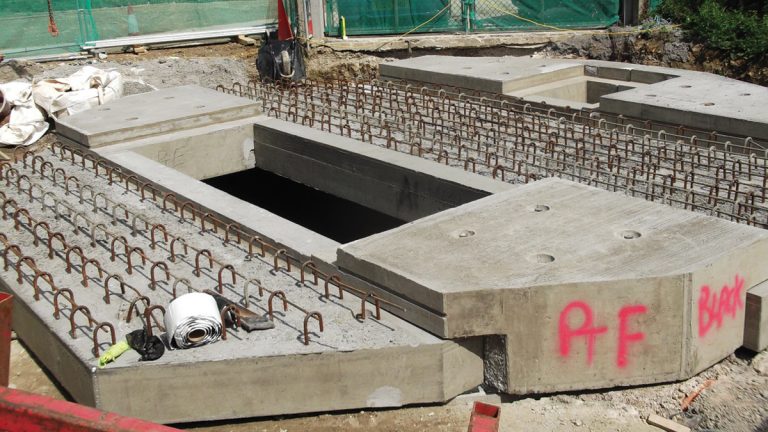
Main shaft cover slabs – Courtesy of NMCNomenca Ltd
Once the cover slabs were set, double tier scaffolding was installed within the shaft so the mechanical fitters could begin their work installing the pump footstools, ductile iron pipework and brackets. Where possible, this equipment was built up at ground level before being lowered into the shaft via a mobile crane.
Western Power Distribution began the power upgrade works in September 2015 which coincided with the NMCNomenca electrical installation of the new MCC and submersible pumps. Western Power installed high voltage (HV) switchgear and a 500kva transformer onto a pre-constructed plinth (forming a new small sub-station on site), and NMCNomenca completed the full installation of the pumping station as per the specialist electrical design.
Phase 4 – Concrete road and completion: By late October, the project was well into its final stages. The new mechanical and electrical equipment (including new permanent swing jib crane) had been commissioned and operational. New galvanized mesh flooring had been installed over the existing wet well and overflow channel openings and safety hand railing had also been installed around the existing cover slab to eliminate tripping hazards.
Final civil engineering work to be completed was the reinforced concrete road which was done in manageable sections to allow staff to continue to move around the site compound safely.
Over the course of the 8 months construction time on site, not one accident, incident or near miss was recorded. In addition to this, the TPS was never taken off line and all incoming flows were continuously managed and pumped to the nearby sewage treatment works.
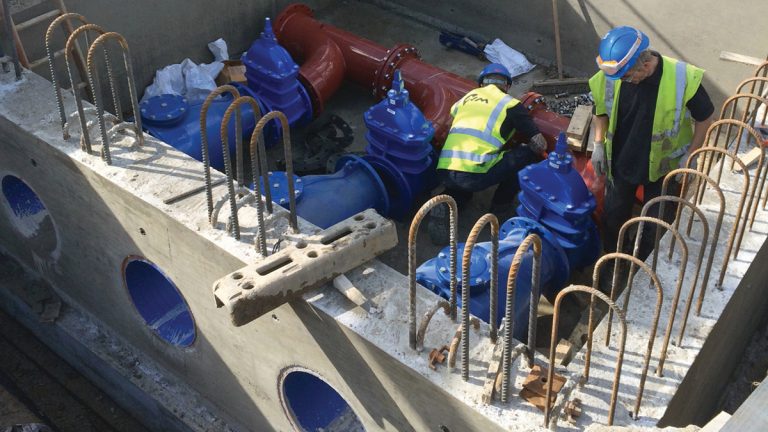
Valve chamber installation – Courtesy of NMCNomenca Ltd
Project innovations and successes
Continual management of incoming flows: During any sewage pumping station refurbishment one of the major obstacles to overcome is ensuring all incoming flows are dealt with safely. This can be particularly difficult when working space and existing wet well storage are at a premium, as was the case at Blackwell.
To bolster the overpumping options on site a new connection onto the existing sewage main was constructed just outside the works compound. This connection enabled temporary submersible pumps and overland pipework to be used to easily manage the flows whilst work was undertaken safely in isolated chambers.
Flow diversion channel: To enable the site team to isolate the existing wet well safely, a flow diversion channel was installed during the final stages of the construction of the main shaft. A small section of the guide collar was broken out and a 600mm diameter connection was laid up to the existing sewer pipe. A manhole ring was placed over the incoming sewer and, when required, the top section of the sewer pipe was removed and an inflatable pipe stopper was inserted into the pipe and inflated allowed all flows to be diverted directly into the main shaft.

(left) Overpumping connection and (right) bypass stopper inflated – Courtesy of NMCNomenca Ltd
Conclusion
The Blackwell Gloves Lane TPS scheme was required to solve overflow and pump failure issues at the aging asset. The location of the station within a tight compound up a narrow road and the presence of coal measures in the area meant a challenging build for the team.
Principal designer and contractor NMCNomenca started on site on 8 April 2015. Eastwood and Partners was the structural consultant and Active Tunnelling Ltd was the principal sub-contractor. The £810,000 scheme was successfully delivered on 4 December 2015, providing Severn Trent Water with a brand new pumping station designed to current industry standards.





